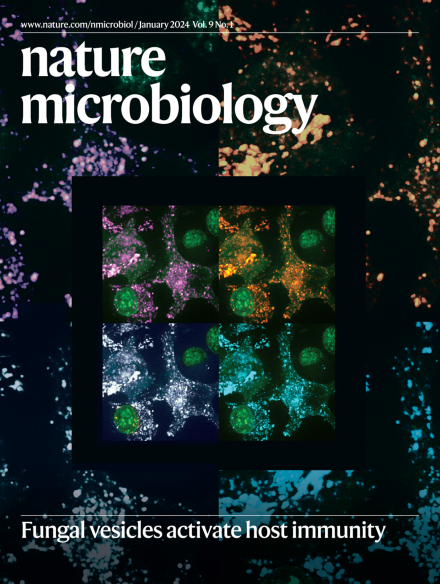Dipeptidase 1 is a functional receptor for a porcine coronavirus.
IF 19.4
1区 生物学
Q1 MICROBIOLOGY
引用次数: 0
Abstract
Coronaviruses of the subgenus Embecovirus include several important pathogens, such as the human seasonal coronaviruses HKU1 and OC43, bovine coronavirus and porcine haemagglutinating encephalomyelitis virus (PHEV). While sialic acid is thought to be required for embecovirus entry, protein receptors remain unknown for most of these viruses. Here we show that PHEV does not require sialic acid for entry and instead uses dipeptidase 1 (DPEP1) as a receptor. Cryo-electron microscopy at 3.4-4.4 Å resolution revealed that, unlike other embecoviruses, PHEV displays both open and closed conformations of its spike trimer at steady state. The spike receptor-binding domain (RBD) exhibits extremely high sequence variability across embecoviruses, and we found that DPEP1 usage is specific to PHEV. In contrast, the X-ray structure of the RBD-DPEP1 complex at 2.25 Å showed that the structural elements involved in receptor binding are conserved, highlighting the remarkable versatility of this structural organization in adopting novel receptor specificities.二肽酶1是猪冠状病毒的功能性受体。
Embecovirus亚属的冠状病毒包括几种重要的病原体,如人类季节性冠状病毒HKU1和OC43、牛冠状病毒和猪血凝性脑脊髓炎病毒(PHEV)。虽然唾液酸被认为是embecovirus进入所必需的,但大多数这些病毒的蛋白受体仍然未知。在这里,我们发现PHEV不需要唾液酸进入,而是使用二肽酶1 (DPEP1)作为受体。低温电子显微镜在3.4-4.4 Å分辨率下显示,与其他embecovirus不同,PHEV在稳定状态下显示其spike三聚体的开放和封闭构象。刺突受体结合域(RBD)在embecoviruses中表现出极高的序列变异性,我们发现DPEP1的使用是PHEV特异性的。相比之下,RBD-DPEP1复合物在2.25 Å的x射线结构表明,参与受体结合的结构元件是保守的,突出了这种结构组织在采用新的受体特异性方面的显着多功能性。
本文章由计算机程序翻译,如有差异,请以英文原文为准。
求助全文
约1分钟内获得全文
求助全文
来源期刊

Nature Microbiology
Immunology and Microbiology-Microbiology
CiteScore
44.40
自引率
1.10%
发文量
226
期刊介绍:
Nature Microbiology aims to cover a comprehensive range of topics related to microorganisms. This includes:
Evolution: The journal is interested in exploring the evolutionary aspects of microorganisms. This may include research on their genetic diversity, adaptation, and speciation over time.
Physiology and cell biology: Nature Microbiology seeks to understand the functions and characteristics of microorganisms at the cellular and physiological levels. This may involve studying their metabolism, growth patterns, and cellular processes.
Interactions: The journal focuses on the interactions microorganisms have with each other, as well as their interactions with hosts or the environment. This encompasses investigations into microbial communities, symbiotic relationships, and microbial responses to different environments.
Societal significance: Nature Microbiology recognizes the societal impact of microorganisms and welcomes studies that explore their practical applications. This may include research on microbial diseases, biotechnology, or environmental remediation.
In summary, Nature Microbiology is interested in research related to the evolution, physiology and cell biology of microorganisms, their interactions, and their societal relevance.
 求助内容:
求助内容: 应助结果提醒方式:
应助结果提醒方式:


